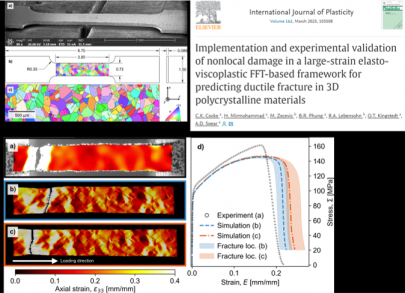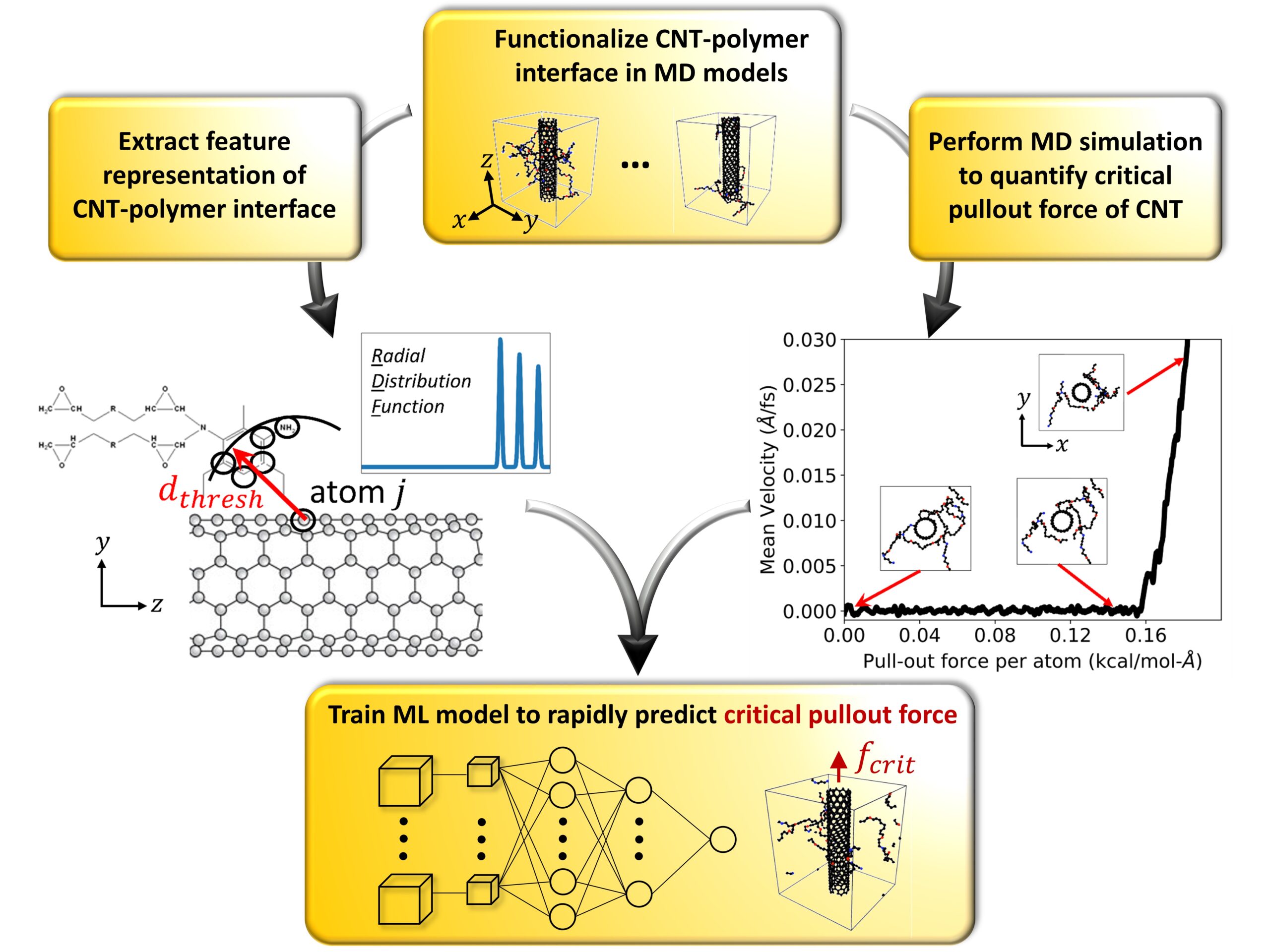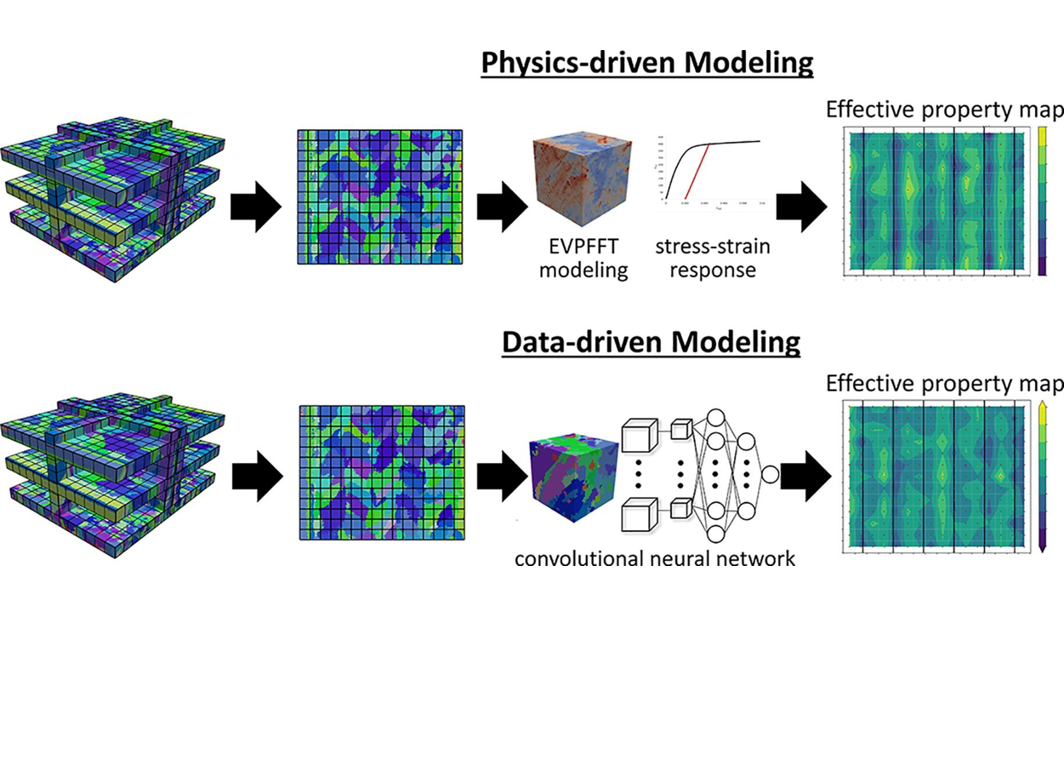Our latest work on an interleaved physics-based deep-learning approach to accelerate high-fidelity predictions of microstructurally small fatigue crack propagation in 3D polycrystals has just been published in npj Computational Materials! We believe the work provides a template for many time-series applications in materials science, beyond fatigue and fracture. Abstract: Conventional fracture mechanics asserts that the relevant physics governing small crack growth occurs near the crack front. However, for fatigue, computing these physics for each crack-growth increment over the entire microstructurally small crack regime is computationally intractable. Properly trained deep-learning surrogate models can massively accelerate fatigue crack-growth predictions by virtually...
Continue readingDamage-enabled FFT simulations provide insight into failure of 3D polycrystalline materials
The MMM Lab and collaborators from Los Alamos National Laboratory and the High Strain-Rate Mechanics of Materials Lab at Utah published work on their recent implementation and experimental validation of a damage-enabled crystal-plasticity FFT code. Click here to read the full paper in the International Journal of Plasticity!...
Continue readingNew work on Void Descriptor Function published in Acta Materialia
Recent MMM Lab graduate, Dillon Watring, and collaborators from the National Institute of Standards and Technology (NIST) published work on the extension and experimental evaluation of a void descriptor function, or VDF. The VDF is intended to provide a unique parameter to characterize complex void networks in structural metals, including additively manufactured metals. Compared to other pore-related metrics reported in the literature, the VDF parameter has been shown to be more strongly correlated with ductile-metal failure properties, including fracture location. Click here to learn more!...
Continue readingRecent review article on physics-driven vs. data-driven modeling for metal additive manufacturing
The MMM Lab and collaborators recently published a review article describing the differences, similarities, and interactions between physics-driven and data-driven approaches for modeling process-structure-property relationships in metal additive manufacturing (AM). The article is published in the new open-access Journal of Physics: Materials. Access the article here! ...
Continue readingWork with Michigan Tech featured in Materials Today!
Our recent paper published in Composites Science and Technology was featured in Materials Today! The work is a collaboration with researchers from Michigan Tech and demonstrates the use of machine learning to accelerate failure predictions of carbon nanotube-polymer interfaces using training data from molecular dynamics simulations. The research is supported by the NASA Space Technology Research Institute US-COMP. Click here to read the news article....
Continue readingApplying Deep Learning to Additive Manufacturing of Metals
Abstract: In this work, we investigate the performance of data-driven modeling for mechanical property prediction of a simulated microstructural dataset. The dataset comprises realistic microstructural subvolumes of metal additive-manufactured stainless steel 316L and corresponding effective mechanical properties that were generated with a physics-driven modeling framework. The data-driven models leveraged for this work include Ridge regression, XGBoost, and a custom 3D convolutional neural network (CNN) based on VGGNet. Morphological and crystallographic features describing each microstructure serve as the inputs for the Ridge regression and XGBoost models. The CNN is trained with a 3D image of the microstructure represented by progressively...
Continue readingCongrats to Carl, John, and Jimmy!
Congratulations to Carl Herriott, John Erickson, and Junyan “Jimmy” He for successfully completing their M.S. degrees! Carl, John, and Jimmy have made significant contributions to the MMM Lab and to the literature in their fields. We are very proud of all three graduates and wish them the very best in their careers. Carl’s thesis, entitled Predicting Spatial Variability of Mechanical Properties in Additively Manufactured Metals with Multiphysics Modeling and Machine Learning, includes two journal articles, which can be accessed below. Carl is currently employed at Sandia National Laboratories in Livermore, CA. Herriott, C.F., Li, X., Kouraytem, N., Tari, V.,...
Continue readingEffect of Grain Structure on Crush Response of Open-Cell Metal Foam
Abstract: The mechanical response of open-cell metallic foams depends strongly on their hierarchical structure, which ranges from the grain scale, to the scale of individual struts, to the scale of the bulk foam. The objective of this study is to investigate the effect of grain structure on the compressive mechanical response of open-cell metallic foam using a crystal-plasticity finite-element-based framework. Multiple polycrystalline instantiations (overlaid on a foam volume derived from X-ray tomography) are simulated to quantify the grain-size effect on crushing response of investment-cast aluminum foam. The high-fidelity numerical framework captures the deformation mechanisms across multiple length scales and is...
Continue readingML+MD to predict strength of CNT-polymer interface
Abstract Modern aerospace applications require lightweight materials with exceptionally high strength and stiffness. Carbon nanotube (CNT)-reinforced composites have great potential in addressing these requirements. However, one critical factor limiting the potential of CNT-reinforced composites is the limited load transfer capability between CNTs through a polymer matrix, which arises due to low CNT-polymer interfacial shear strength at a molecular scale. While molecular dynamics (MD) simulations can be employed to investigate the CNT-polymer interface, such simulations are computationally expensive. It is thus intractable to explore a sufficiently large design space for interface modifications and optimization using MD simulations alone, motivating the...
Continue readingHigh-fidelity simulations of impact-induce skull fracture in infants
Abstract: Infant skull fractures are common in both accidental and abusive head trauma, but identifying the cause of injury may be challenging without adequate evidence. To better understand the mechanics of infant skull fracture and identify environmental variables that lead to certain skull fracture patterns, we developed an innovative computational framework that utilizes linear elastic fracture mechanics theory to predict skull fracture as a first step to study this problem. The finite-element method and adaptive-remeshing technique were employed to simulate high-fidelity, geometrically explicit crack propagation in an infant skull following impact. In the framework, three modes of stress intensity...
Continue reading





